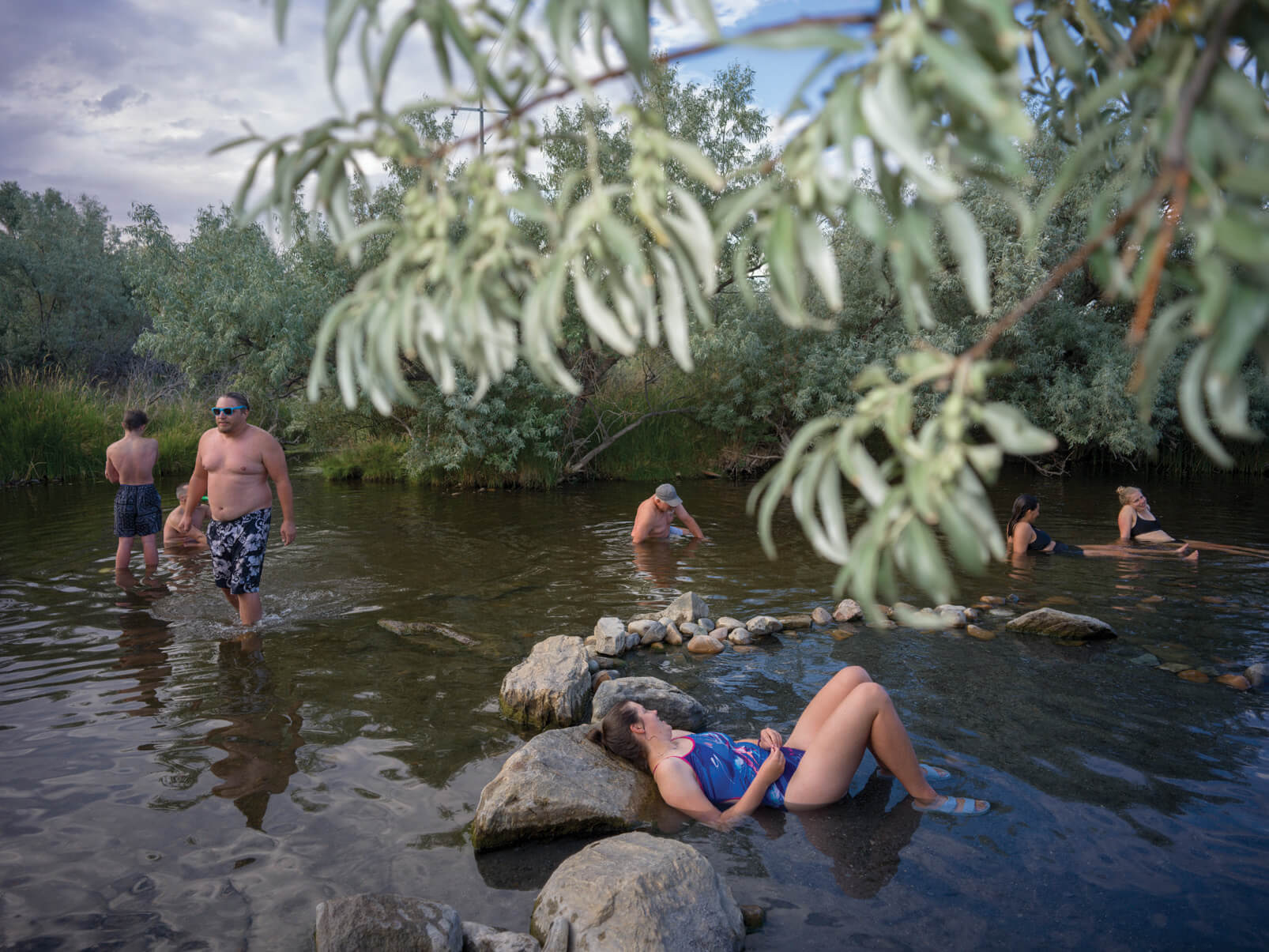
25 Sep Soaking in Saratoga
Nestled between the Snowy Range and the Sierra Madre Mountains, the hamlet of Saratoga, Wyoming is full of historical nods. Hotel Wolf, which opened in 1893, anchors downtown. Guide shops, restaurants, and art galleries line Bridge Avenue. The North Platte River divides the town, whose motto, “Where the trout leap in Main Street,” is posted as a welcome sign. The willow-lined banks are thick enough to obscure resident moose that cruise the morning hours, trotting downstream, blowing clouds of breath into the frosty air.
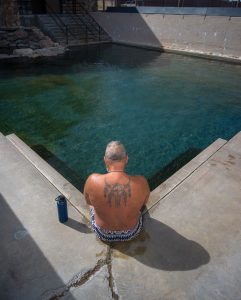
Though Saratoga, Wyoming might be best known for its blue-ribbon trout fishing and stunning mountain vistas, it’s also widely acclaimed for its natural hot springs near the junction of Spring Creek and the North Platte River, with the developed Hobo Hot Pool remaining free to the public and open 24 hours a day, every day of the year.
Although Saratoga is primarily known for its blue-ribbon trout fishing, high-end private golf courses, and mountain retreats, it is also recognized for its hot springs, which bubble from the landscape in several locations near where Spring Creek meets the North Platte River.
One such hot spring, the Hobo Hot Pool, is owned and operated by the city and is free to the public 24 hours a day, 365 days a year. This isn’t by accident. The residents and committed hot-pool soakers are also caretakers and amateur historians. They say that the concept of free access originated with the first people to use the area, and it’s the community of Saratoga’s responsibility to uphold that tradition.
Dick Perue and Chilly Rollison are hot-springs aficionados who soak nearly every morning. They are keenly interested in keeping the Hobo pool true to its roots, about which both men are well-versed: Perue ran The Saratoga Sun newspaper for decades while Rollison studied history, with a focus on Native American communities. Rollison says that the Ute, Cheyenne, and Shoshone all used the area’s healing waters at various times in the past. (Legend has it that the tribes dropped their beefs when they came to soak. It was a peaceful place.) Thousands of years of archaeological evidence further suggests that the area was a popular gathering spot for Indigenous peoples. Fur trappers, mountain men, and explorers also recognized the uniqueness of the area and set down roots.
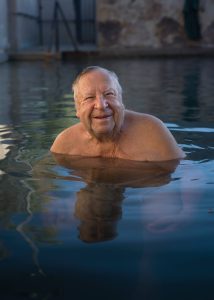
Hot-springs aficionado Dick Perue enjoys his daily soak at the Hobo pool, often accompanied by his pal and fellow enthusiast Chilly Rollison.
Rollison describes other locations on private lands where geothermal hot water seeps to the surface, and a few historic houses in town once used the hot groundwater as a heating source.
The Hobo pool where people soak for free today is not the original hot springs. The original pool, once known as the Indian Baths, was purchased by a private entity, developed into a resort and brewery, and now requires a stay at the Saratoga Inn in order to soak. The Hobo Hot Pool, which sits on 20 acres of public land, wasn’t discovered until 1917, says Rollison during a meeting at the public pool. That year marked the second-largest flood in recorded history, which eroded the banks along Spring Creek, exposing the new hot spring.
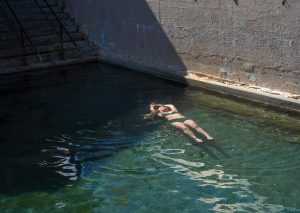
Relaxation is the name of the game at Hobo pool, the name of which derives in part from its location on the Saratoga/Encampment Railway and former use by hobos who would get off the rail to soak in the warm waters.
When the locals realized a new hot spring was emerging, they built circular rock pools and began to use them. In 1936, the Civilian Conservation Corps built stairs and other structures that would become the modern Hobo Hot Pool. Today, the facility includes a swimming pool, a changing room with showers, and two established pools with varying temperatures.
Saratoga mineral water doesn’t emit the strong sulfur smell that so many other hot springs have. Other than the brown sign on Main Street directing you to the free soaking area, you’d hardly know there was a hot springs complex in Saratoga. You might drive through town and head south to the twin towns of Riverside and Encampment without even knowing what you were missing.
“It does not have the same qualities as volcanic springs all over the country,” says Perue. He points out that the water in the center of the pool, known as the Lobster Pot, is pure enough to drink. He says samples have been collected and analyzed.
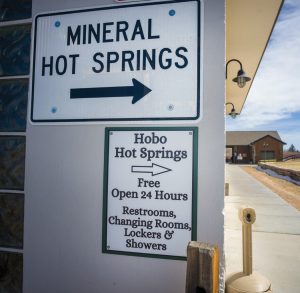
Today’s Hobo Hot Pool is not the original hot springs: The original pool, once known as the Indian Baths, is now part of a privately-owned resort. The current pool was discovered in 1917, after the second-largest flood in recorded history eroded the banks along Spring Creek, exposing the new spring.
“We also don’t know how old this water is,” says Rollison. “Is this water from last year’s snow melt? Or from 21,000 years ago?”
Upon entering Valley Grocery, a wave of nostalgia sweeps over me. When I first moved to Wyoming, I held one of the lowest-ranking positions at the University of Wyoming in Laramie. With no chance of tenure or promotion, I invested my free time into traveling the backcountry, getting my two-wheel-drive truck stuck in sandy draws and bumping over the sparsely populated cattle country with no real destination in mind. After a semester teaching English composition, I’d drive over the Snowy Range and descend into the North Platte Valley. I camped at the Saratoga Reservoir and took late-night dips in the Hobo pool with a cast of other rootless travelers. The unencumbered feeling I had in those days struck me as freedom. And there was an open- endedness to those weekends I spent walking up the Encampment River with my chocolate labrador, those first chilly nights in my tent when I heard coyotes out on the range. The Hobo pool and the saloon at Hotel Wolf fit my ideas about the Western ethos that prioritized individualism and freedom.
The little grocer hasn’t changed much since I first went there 20-some years ago to replenish my sandwich-making supplies. Like many things in the North Platte Valley, the store, with its big-game mounts and overtures to a bygone era, seems to be a throwback, an anachronism. A white-coated butcher comes out to chitchat with customers as I troll the too-narrow aisles for Greek yogurt and purified water. (It’s recommended that you consume a quart of water for each half hour you soak.) However, my takeaway is that the store and the whole valley, really, has successfully resisted the transformations that have affected so many other Western mountain towns. Here in Saratoga, you get the same aspen trees, moose, hot springs, and blue-ribbon trout fishing at a fraction of the cost you’d encounter in, say, Steamboat, just a few hours down the road. For fun, I stop at a house with a for-sale sign in the yard. It turns out to be somewhere in the ballpark of what you’d pay in Casper.
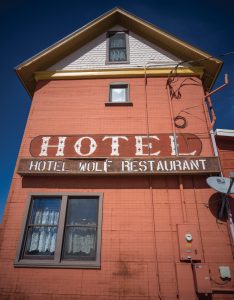
Hotel Wolf has been a Saratoga staple since 1893. Though updates have kept the establishment comfortable for modern visitors, it still boasts an abundance of Old-West charm.
Maybe one day I could get a place and soak every day, too, I think.
After perusing downtown, I join Perue in his home. His living room is a testament to a career in journalism, every surface carpeted with papers and notes. He has a stack of black-and-white photos spread out like playing cards on a table. One of the images, dated 1943, shows a woman cradling an infant at the hot springs.
He rummages for a copy of his publication on the Hobo Hot Pool. The pamphlet features sepia photos depicting Saratoga and the hot springs throughout history. Perue offers “Go with the Flow” walking tours in the summer. These include visits to historical buildings, a trip to Veterans’ Island, and a stop at the old building where the hot springs water was bottled and sold as a medicinal beverage under the brand name Aquatone. Perue’s tour culminates in a lunch at one of the local restaurants.
Perue, who first started using the mineral baths in 1938, holds a degree in journalism and a minor in history from the University of Wyoming. He bought The Saratoga Sun and published the type of specialized, small-town stories that are becoming increasingly rare. Retired now, Perue is the authority on the area’s history. He is also one of the forces that keeps the Hobo pool true to its bedrock values. When well-meaning people suggest fees or regulations to bring the Hobo pool into the modern era, Perue and a few others are at the town meetings ready to object.
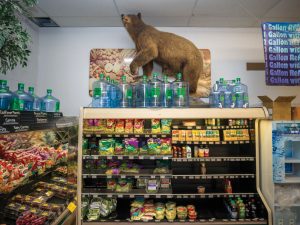
It’s hard to imagine a more quintessential mark of the contemporary rural West than the taxidermied bear in Valley Grocery, a nostalgia-inducing mom-and-pop shop that carries all a person could need for an impromptu woodland picnic.
“The ‘hobo’ name comes from two different things: because we don’t charge for it and because it was on the Saratoga/Encampment Railway, and the hobos would get off and use the pool,” says Perue.
Before I leave, Perue finds an old photo depicting Della Clark, an area rancher whose family sipped the mineral water for its healthful qualities. In the image, she is drinking from a dipper filled with mineral water. She’s wearing a dark cloak and grinning. And you get the feeling she’s poised for a joke, a little sense of humor from over 100 years ago. Perue says the photo was taken around 1911.
Before I head out, I stop at the hot spring for a final dip. The stars are out in astounding numbers. The parking lot is nearly empty. Through the swirls of steam, I can see pale human bodies. I slip into the pool and listen to the low murmur of conversation. Occasionally, a few soakers rise, dash out to the river, and soak in the improvised hot pools that face Spring Creek. This, they tell me, is a more primitive experience. But the landing is icy, and I feel good where I am. I strike up a conversation with an overland trucker who hauls frozen turkeys from the Midwest to California. He says he never misses an opportunity to get off I-80 and take a soak.
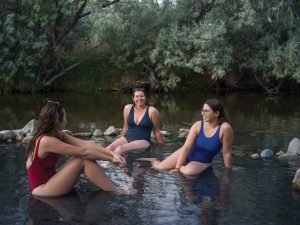
A relaxing soak with friends makes for a perfect afternoon reprieve from the hustle and bustle of modernity.
One young man loiters near the Lobster Pot, a section where the thermal water emerges from the earth at nearly 120 degrees Fahrenheit. Only the truly dedicated can withstand this kind of heat. The man takes several deep breaths, then wills himself into the pot. A minute later, he explodes from the area, drinks some water, and repeats the process. Clearly, he’s going through something.
But it seems private, something he’s willingly working out for himself between the icy benches and the Lobster Pot. The steam wavers from his body as he gathers himself and plunges back in.
David Zoby is a freelance writer from Casper, Wyoming who has been writing and publishing essays and stories for over 20 years. His work regularly appears in Gray’s Sporting Journal, The Drake, and The Sun Magazine; @davidzoby.
Natalie Behring is a freelance photojournalist based in Victor, Idaho. Behring has worked for major publications throughout the world and recently returned to Idaho to be close to her family. When not taking photos, she can be found hiking in the mountains with her border collie and hanging trail cameras in trees.



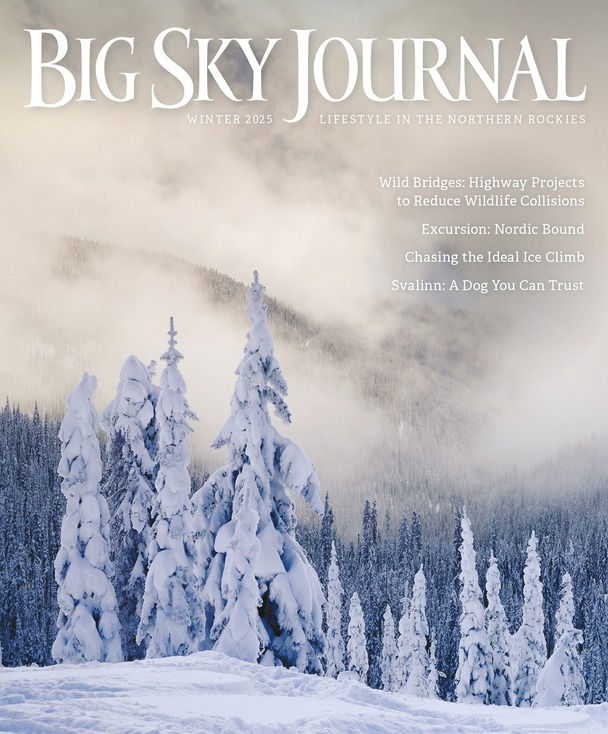
No Comments